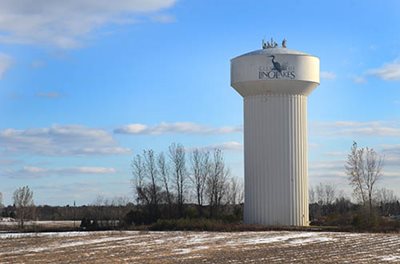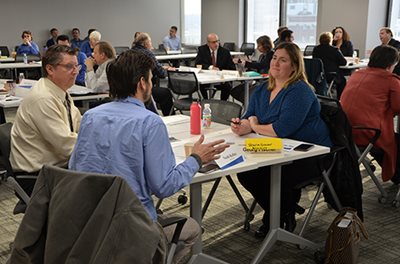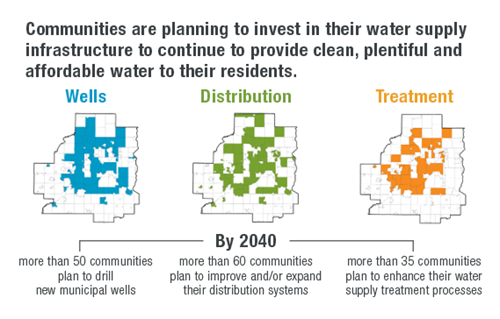 Industries have reduced their water consumption by hundreds of thousands of gallons of water annually. Cities have collaboratively developed plans for water sharing where supplies are limited or in jeopardy. Property owners have adopted lawn irrigation practices that save them money and conserve groundwater.
Industries have reduced their water consumption by hundreds of thousands of gallons of water annually. Cities have collaboratively developed plans for water sharing where supplies are limited or in jeopardy. Property owners have adopted lawn irrigation practices that save them money and conserve groundwater.
These are just a few examples of how the Metropolitan Council’s work in water supply planning is benefiting the region. A new report, Water Supply Planning in the Twin Cities Metro (PDF), describes the many positive outcomes from the Minnesota Legislature’s decision in 2005 to give regional water supply planning responsibilities to the Met Council.
“We have a unique role when it comes to water supply,” said Met Council Chair Charlie Zelle. “We are not a water supplier nor are we a regulator. Where we add significant value is collaborating with water utilities and other water agencies in long-range planning, providing data and analysis, giving grants for water conservation, and facilitating sub-regional water partnerships.
“Our work is designed and applied to ensure local water suppliers have control of and responsibility for their water supply systems,” Zelle added. “Through our work with our partners, we help bolster the livability of the region, foster economic growth and prosperity, and alleviate competition and conflict over water supply.”
Regional water supply is plentiful, but not limitless
More than 3.1 million people live in the seven-county metro area, and in 2019, the region’s businesses and institutions offered nearly 1.8 million jobs, including at 15 Fortune 500 company headquarters. People made more than 63 million visits to regional parks. All these people and activities are dependent on clean and plentiful water supplies.
Nineteen municipalities rely on the Mississippi River for their water, and some of those use a mix of river water and groundwater. But 75% of the region’s population relies solely on groundwater from aquifers — underground layers of water-bearing rock.
While the region’s diverse water supplies are relatively abundant, we do face some challenges that need attention and — in some cases — action. Examples of the Council’s water supply work:
-
In 2020, the Council worked with the cities of Corcoran, Dayton, Ramsey, and Rogers on a study to understand the relative costs and implementation issues of four different approaches to a multi-community water supply.
-
Since 2013, the Council has supported industrial water conservation efforts through the University of Minnesota Technical Assistance Program. In the first five years alone, process improvements and other efficiencies recommended by student interns placed in metro area industries and other organizations resulted in savings of $486,000 and 87 million gallons of water annually.
-
Metro Model — The Council, with assistance from many technical partners, developed a regional groundwater flow model. The model provides fundamental data for municipalities to plan for future water supplies. It helps answer questions such as:
-
Given projected water demands, what impacts may be expected on groundwater levels and groundwater-dependent surface-water features?
-
What combinations of source aquifers, well locations, and withdrawal rates can achieve sustainable water consumption?

Working in partnership with local governments and water agencies
The Metropolitan Area Water Supply Advisory Committee guides the Council’s water supply planning activities. The committee includes representatives from the state departments of agriculture, health, and natural resources; counties and cities; and municipal water utilities. A technical advisory committee, with federal, state, and local representation, provides scientific and engineering expertise to the planning and implementation work.
“Water supply planning in this region since 2005 reflects a partnered approach between the Metropolitan Council, local governments [and] other water-specific agencies,” said Mark Maloney, Public Works Director, Shoreview. “The greatest value of this partnered approach is that documents like the Master Water Supply Plan are informed by the real experiences and expertise of local water suppliers that the pubic has come to trust for safe and sustainable delivery of drinking water.”

Looking to the future
The region’s population is expected to continue growing, with impacts to land use and water demand and the systems that supply it. In 2015, the region used about 350 million gallons of water per day. That is projected to rise to 450 million by 2040.
Dozens of municipal water utilities are planning to invest in their water supply infrastructure in the next 20 years to continue to provide clean, plentiful, and affordable water to their residents. This includes drilling new wells, improving or expanding their water distribution systems, and/or enhancing their water treatment processes. The Council, in turn, will support efficiency incentives and sustainability efforts of local governments.
Although much has been done through the water supply planning work of the Council and its partners, new questions continue to emerge:
-
How could equity be implemented in water supply activities?
-
What is the impact of climate change on our resources and operations in the water supply sector?
-
How can we strengthen land use and water supply planning connections?
-
What can we do to prevent contamination of our water supply sources and respond more effectively to emerging contamination, such as PFAs and chloride?
“In an era when many parts of the U.S. and the world have serious water issues today, our region is relatively well-positioned to be able to supply clean water to our residents for decades to come,” Zelle said. “The planning infrastructure set up by the legislature and the cooperative efforts of all our water partners play an important role in our successful future.”
Water Supply Planning in the Twin Cities Metro (PDF)